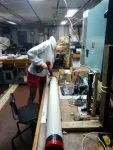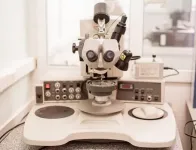New catalyst makes styrene manufacturing cheaper, greener
2021-02-26
(Press-News.org) Chemical engineering researchers have developed a new catalyst that significantly increases yield in styrene manufacturing, while simultaneously reducing energy use and greenhouse gas emissions.
"Styrene is a synthetic chemical that is used to make a variety of plastics, resins and other materials," says Fanxing Li, corresponding author of the work and Alcoa Professor of Chemical Engineering at North Carolina State University. "Because it is in such widespread use, we are pleased that we could develop a technology that is cost effective and will reduce the environmental impact of styrene manufacturing." Industry estimates predict that manufacturers will be producing more than 33 million tons of styrene each year by 2023.
Conventional styrene production technologies have a single-pass yield of about 54%. In other words, for every 100 units of feedstock you put into the process, you would get 54 units of styrene out of each pass. Using their new catalyst, the researchers were able to achieve a single-pass yield of 91%.
The conversion process takes place at 500-600 degrees Celsius - the same temperature range as conventional styrene manufacturing processes. However, there is a big difference.
"Current techniques require injecting very large volumes of steam into the reactor where the conversion takes place," says Yunfei Gao, a postdoctoral scholar at NC State and co-lead author of a paper on the work. "Our technique requires no steam. In practical terms, this drastically reduces the amount of energy needed to perform the conversion."
Specifically, the conversion process that incorporates the new catalyst uses 82% less energy - and reduces carbon dioxide emissions by 79%.
"These advances are made possible by the engineered design of the catalyst itself," says Xing Zhu, co-lead author of the paper and a researcher at the Kunming University of Science and Technology (KUST). "The new redox catalyst has a potassium ferrite surface for the catalytic phase and a mixed calcium manganese oxide core for lattice oxygen storage." Zhu worked on the project as a visiting scholar at NC State.
"In order to adopt the new catalyst, styrene manufacturers would need to adopt a different style of reactor than they are currently using," Li says. "They would need something similar to a CATOFIN® reactor. But those are already in widespread use for other industrial applications. And the cost savings from the new process should be significant."
INFORMATION:
The paper, "A tailored multi-functional catalyst for ultra-efficient styrene production under a cyclic redox scheme," is published in the journal Nature Communications. The paper is co-authored by Xijun Wang, Vasudev Haribal, Junchen Liu and Luke Neal of NC State; Zhenghong Bao and Zili Wu of Oak Ridge National Laboratory; and Hua Wang of KUST.
The research was done with support from the U.S. Department of Energy, under RAPID subaward DE-EE0007888-05-6; the National Science Foundation, under grant number 1923468; and the Kenan Institute for Engineering, Technology and Science at NC State.
The researchers have received a patent for the new technology.
ELSE PRESS RELEASES FROM THIS DATE:
2021-02-26
The koala retrovirus (KoRV) is a virus which, like other retroviruses such as HIV, inserts itself into the DNA of an infected cell. At some point in the past 50,000 years, KoRV has infected the egg or sperm cells of koalas, leading to offspring that carry the retrovirus in every cell in their body. The entire koala population of Queensland and New South Wales in Australia now carry copies of KoRV in their genome. All animals, including humans, have gone through similar "germ line" infections by retroviruses at some point in their evolutionary history and contain many ancient retroviruses in their genomes. These retroviruses have, over millions of years, mutated into degraded, inactive forms that are no longer harmful to the host. Since in most animal ...
2021-02-26
NARRAGANSETT, R.I. - February 26, 2021 - A team of researchers from the University of Rhode Island's END ...
2021-02-26
When a muscle grows, because its owner is still growing too or has started exercising regularly, some of the stem cells in this muscle develop into new muscle cells. The same thing happens when an injured muscle starts to heal. At the same time, however, the muscle stem cells must produce further stem cells - i.e., renew themselves - as their supply would otherwise be depleted very quickly. This requires that the cells involved in muscle growth communicate with each other.
Muscle growth is regulated by the Notch signaling pathway
Two years ago, a team of researchers led by Professor Carmen Birchmeier, head of the Developmental Biology/Signal Transduction ...
2021-02-26
A new study shows that a widespread decline in abundance of emergent insects - whose immature stages develop in lakes and streams while the adults live on land - can help to explain the alarming decline in abundance and diversity of aerial insectivorous birds (i.e. preying on flying insects) across the USA. In turn, the decline in emergent insects appears to be driven by human disturbance and pollution of water bodies, especially in streams. This study, published in END ...
2021-02-26
Who would have thought that a small basic compound like vitamin B6 in the banana or fish you had this morning may be key to your body's robust response against COVID-19?
Studies have so far explored the benefits of vitamins D and C and minerals like zinc and magnesium in fortifying immune response against COVID-19. But research on vitamin B6 has been mostly missing. Food scientist END ...
2021-02-26
HDL cholesterol (high-density lipoprotein cholesterol) or good cholesterol is associated with a decreased risk of cardiovascular disease as it transports cholesterol deposited in the arteries to the liver to be eliminated. This contrasts with the so-called bad cholesterol, LDL (low-density lipoprotein cholesterol), which causes cholesterol to accumulate in the arteries and increases cardiovascular risk. Although drugs that lower bad cholesterol reduce cardiovascular risk, those that raise good cholesterol have not proven effective in reducing the risk of heart disease. This paradox has called into question the ...
2021-02-26
Whilst the nation has taken to washing its hands regularly since the start of the pandemic, other individual behaviours, such as cleaning and disinfecting surfaces or social distancing within the home, have proved harder to stick, say the researchers behind the behaviour change website 'Germ Defence'.
In their new study, published today (Friday 26 February 2021) in the Journal of Medical Internet Research, psychologists from the universities of Bath, Bristol and Southampton, warn of the continuing risks of household transmission of COVID-19 and the ongoing importance of breaking chains of transmission now and in the future.
Their research analysed user data of the ...
2021-02-26
Treating critically ill COVID-19 patients with drugs typically used for rheumatoid arthritis may significantly improve survival, a landmark study has found.
The findings, which were announced in January and have now been peer-reviewed and published in the New England Journal of Medicine, come from the REMAP-CAP trial, which evaluates the effect of treatments on a combination of survival and length of time patients need support in an intensive care unit (ICU).
Initial findings reported in November showed that tocilizumab, a drug used to treat arthritis, was likely to improve outcomes among critically ill COVID-19 ...
2021-02-25
Clinical research requires that data be mined for insights. Machine learning, which develops algorithms to find patterns, has difficulty doing this with data related to health records because this type of information is neither static nor regularly collected. A new study developed a transparent and reproducible machine learning tool to facilitate analysis of health information. The tool can be used in clinical forecasting, which can predict trends as well as outcomes in individual patients.
The study, by a researcher at Carnegie Mellon University (CMU), appears in Proceedings of Machine Learning Research.
"Temporal Learning Lite, or TL-Lite, is a visualization and forecasting tool to ...
2021-02-25
Physicists from Russia, Chile, Brazil, Spain, and the UK, have studied how the magnetic properties change in 3D nanowires, promising materials for various magnetic applications, depending on the shape of their cross-section. Particularly, they more deeply probed into the Walker breakdown phenomenon, on the understanding of which the success of the implementation of the future electronics devices depends. The research outcome appears in Scientific Reports.
The cross-sectional geometry of a three-dimensional nanowire affects the domain wall dynamics and therefore is crucial for their control. In turn, managing the DW dynamics under various external conditions is necessary in order to realize the future electronics and computing devices, operating on new physical principles. ...
LAST 30 PRESS RELEASES:
[Press-News.org] New catalyst makes styrene manufacturing cheaper, greener



